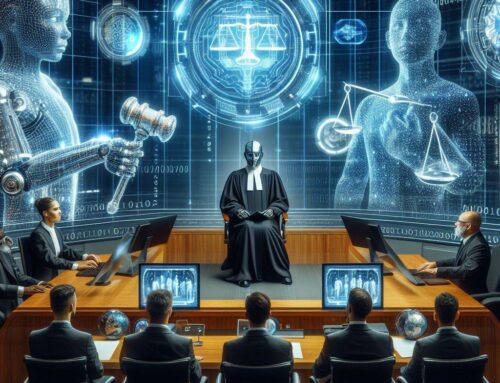Beware Off-The-Shelf IP License Agreements for NFTs
As Lowenstein Sandler attorneys Leah Satlin and Matt Savare explain, conventional IP license terms do not always fit the bill when it comes to NFTs. In this article, they highlight several of the most important clauses to address to ensure your NFT license isn’t trying to fit a square peg in a round role.
Much has been written about the bourgeoning popularity of NFTs (non-fungible tokens) and the opportunities they present to brands and creators. NFTs can offer an interesting new way to leverage a brand’s intellectual property portfolio and can open creators and artists up to a whole new pool of collectors. Out of these new opportunities an important legal issue concerning the intellectual property underlying the asset associated with the NFT has also arisen: what rights should be granted to the NFT purchaser in such IP, if any at all? To answer this question, we must first distinguish between the ownership of the NFT – the unique token on the blockchain – and the asset linked to, or associated with, that NFT and the intellectual property related to such asset.
Some NFT issuers, such as Bored Ape Yacht Club and World of Women, have opted to grant to purchasers a fulsome bundle of rights in the IP underlying the asset associated with the NFT, in many cases including the rights to commercialize such IP. Others have chosen not to grant the purchaser any rights in or to such underlying IP (analogizing the purchase of an NFT to the purchase of a traditional physical good). But the majority of NFT sellers seems to desire a hybrid approach, granting the NFT purchaser a limited license to the underlying IP while retaining certain rights that allow the creators to monetize their works. NFT issuers and their counsel may be tempted, if opting for this middle ground approach, to use an off-the-shelf IP license agreement in connection with the sale of their NFTs, as these traditional IP licenses typically set forth very specific, limited use cases for the licensee. However, when typical IP license language is used in the NFT context, it can often miss the mark. Having drafted numerous licenses involving NFTs, we have identified several standard IP license provisions that need substantial retooling in order to fit the NFT model.
Exclusivity: IP licenses often fall into one of three categories with respect to exclusivity. An exclusive license means that only the licensee (including to the exclusion of the licensor) is permitted to exercise the rights granted in the IP license. This approach seriously hinders the IP owner’s ability to benefit from his or her own creation and tends not to be commonly used unless the IP owner has no capacity to monetize the IP. As opposed to an exclusive license, a “sole” license is an exclusive license that does not exclude the licensor/IP owner. It grants the licensee certain rights to the exclusion of any third party, but still permits the IP owner to use his or her own IP. Lastly, a non-exclusive license means the IP owner can grant the same rights to any third party, a common approach in the context of licensing software. When it comes to NFTs, issuers and their counsel may be tempted to include “non-exclusive” when describing the license and will often find this language in typical IP license provisions. However, the drafter should consider what ambiguities could arrive from “non-exclusive” language in the NFT IP license context. NFT purchasers often (though not always) have the expectation that the NFT they have purchased is “rare,” meaning that it is part of a limited edition or is a completely unique asset. Such purchasers may therefore be surprised to find “non-exclusive” language in the license to the IP underlying the asset linked to their NFT. To mitigate ambiguity and confusion, the license should explain, in no uncertain terms, whether or not the NFT is unique, and the difference between the uniqueness of the NFT and the non-exclusive nature of the license. Perhaps the license will state that, although non-exclusive, the licensor will not grant any third party any rights in or to the IP except with respect to other purchasers of NFTs within the same collection. Whatever the case, simply using “non-exclusive” in an IP license in the NFT context without further explanation could create confusion and friction with prospective NFT purchasers and may not tell the whole story.
Territory: Most standard IP licenses set forth a limited territory in which the licensee may use and exploit the IP. This does not work for NFTs, which are sold and resold all over the world by their very nature.
Transferability: It is common for standard IP licenses to be non-transferable. In the context of NFTs, however, if the NFT linked to the underlying asset is itself transferable, as most are, then the rights in and to the underlying asset should run with the transferable NFT (meaning the license is in fact transferable). This means that counsel must consider whether the NFT is capable of being transferred on the blockchain. If so, then the license grant to the IP underlying the asset linked to the NFT should also be transferable. The NFT issuer still has a choice, however: whether the transferability is permitted solely in the case of a transfer of the NFT in its entirety or if transferability of the license to the IP in the asset can be transferred (or sublicensed) without the transfer of ownership of the NFT linked to such asset. What matters here is that when crafting license language, the drafter provides guidance on what “non-transferable” means (perhaps simply by providing for an exception to non-transferability, i.e., in the case of a transfer in ownership of the NFT). Simply stating that the license is non-transferable, without further explanation, could lead to overall ambiguity if the NFT is itself a transferable token.
Royalties: Often drafters include “royalty-free” in the list of license descriptors, which generally means the licensee is not required to pay the licensor a fee each time the licensee uses, or earns revenue from use of, the IP. Since NFT purchasers usually are not obligated to pay a traditional royalty in connection with their use of the IP, drafters may be tempted to include “royalty-free” language in the license. However, it is important for the drafter to do some digging to determine whether or not the issuer of the NFT has included in the NFT’s smart contract a mechanism for transmitting fees back to the original NFT issuer each time the NFT is sold on the blockchain. This may be regarded as a type of royalty, and therefore the license to the IP underlying the asset linked to the NFT may not accurately be described as “royalty-free,” even if it does not carry the traditional meaning that the NFT purchaser must make payments to the licensor upon each use of the IP.
Grant of Rights: Typical IP license agreements include a laundry list of rights that the licensor is granting to the licensee, often referred to as a “bundle of rights” particularly in a copyright license framework. The right to “use” the IP is not a fulsome license grant; drafters must specify the list of things a licensee can do with the IP for clarity. It is common to see the following list of rights: the right to use, reproduce, distribute, modify, publicly display, publicly perform, and create derivative works based on the IP. Even issuers taking the position that the purchase of an NFT is comparable to the purchase a physical good, like a painting or a baseball card, need to consider the necessity of a limited IP license grant. Such license can be limited to personal, non-commercial use simply to permit the NFT holder to personally enjoy the NFT (after all, without the right to publicly display the IP, the NFT holder would have to keep the NFT hidden in a wallet, never to be seen by anyone other than the owner). On the other end of the spectrum, if the NFT issuer wants to grant the NFT holder a broad bundle of rights, including the right to use the IP for commercial use, the license should say so.
Scope of the License: In addition to the grant of rights, the license must also state the purpose for which the licensee may exercise these rights. NFT issuers and their counsel need to think through what exactly they want NFT purchasers to be able to do with the IP. For example, while a brand like Bored Ape Yacht Club might want to encourage commercial use of its NFTs and the IP related thereto, the brand would still be wise to put some parameters on such commercial use in order to protect its intellectual assets, such as prohibiting use of the IP for the purpose, or with the effect, of promoting hatred, intolerance, or violence, or prohibiting use of the IP for the purpose of competing with the brand. Standard IP licenses will often have an express purpose, such as “for the purpose of developing, manufacturing, marketing, offering for sale, and selling” a certain product. NFT IP license drafters need to think through whether a limited purpose is appropriate or if a broader purpose, with certain restrictions, might be more suitable for the NFT license.
Land of Confusion: In the earliest days of NFTs, many NFTs were sold without any license terms, and purchasers had no way of knowing what rights they had in the underlying asset. In June 2018, Dapper Labs released the NFT License, which was a public license that defined certain rights, obligations, and restrictions for NFT purchasers. Although it was a step in the right direction, version 1.0 of the NFT License had a number of ambiguities, so in January 2019, Dapper Labs released version 2.0 (see https://www.nftlicense.org/), which has been adopted by many NFT issuers, including Larva Labs for its CryptoPunks. In addition to the NFT License, Creative Commons offers several different licensing structures.
Although issuers of NFTs have gotten more careful and precise in their license drafting, there is still a long way to go. Unfortunately, many projects still do not have any license terms or utilize generic licenses that do not adequately address some of the unique elements of NFTs, as described in this article. With the rapid increase in the commercialization of the IP underlying the NFT, issues are well advised to craft careful and precise license terms, and purchasers are equally cautioned to read and understand exactly what rights they are purchasing.
About The Authors
Leah Satlin is an intellectual property and commercial law specialist at Lowenstein Sandler. She represents clients in technology transactions where intellectual property is a key component, particularly in the education, advertising, financial, and entertainment industries.
Matt Savare is the Partner Chair for Commercial Contracts and the Vice Chair of Lowenstein Crypto at Lowenstein Sandler. A veteran of high-profile representations in the digital advertising, media, and entertainment sectors, he has represented clients in copyright, trademark, trade secret, and right-of-publicity matters—with a particular emphasis on how new and emerging technologies are disrupting traditional businesses.

Don’t miss out – Find out more today



